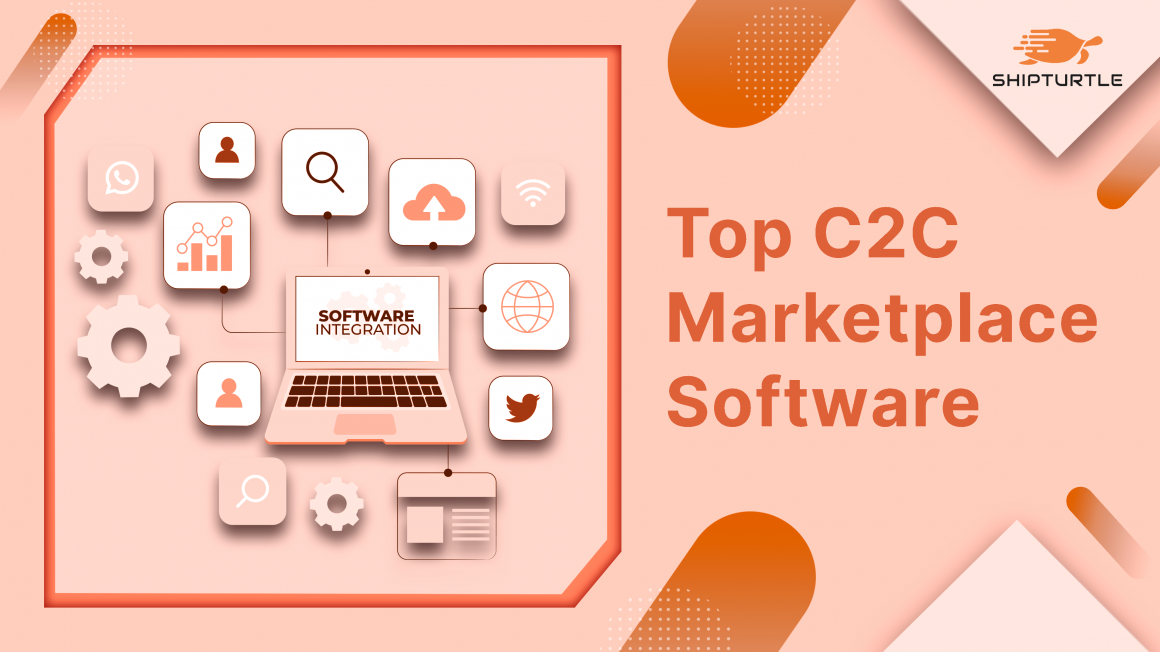The sharing economy has fundamentally reshaped how we access and utilize resources. From renting spare rooms to borrowing power tools, individuals are increasingly embracing collaborative consumption. As this trend continues to flourish, the demand for robust C2C (consumer-to-consumer) marketplace software has skyrocketed.
This comprehensive guide delves into the world of C2C marketplace software, empowering you to navigate the diverse landscape and choose the perfect platform for your vision. We’ll explore the leading contenders, dissect their unique advantages, and equip you with crucial factors to consider during your selection process.
Here are the top contenders:
| Shipturtle (simplest of all) | Sharetribe | Yo!Kart |
| Marketplacer | ZielCommerce | CS-Cart Multi-Vendor |
1. Shipturtle
- Price: Free Shopify app to install. The basic plan starts at $29/month. One-time C2C functionality add-on at $50
- Benefits: Integrates seamlessly with Shopify, easy to set up, affordable C2C add-on.
- Platform: Shopify app.
- Unique points: Ideal for existing Shopify stores, user-friendly interface for vendors.
Here’s how you can transform your existing marketplace on Shopify into a C2C marketplace:
1. Buy C2C functionality as an add-on:
- Ensure you have an active Shopify store.
- Install the Shipturtle Shopify app and subscribe to the base plan.
- Log in to your ShipTurtle account.
- Navigate to “Settings” > “Subscription and Billing.”
- Purchase the C2C add-on to activate consumer-to-consumer features.
2. Get the C2C Code Snippet:
- Locate the code snippet with the “Become a Seller” button.
- <button id=”st-become-a-seller-btn”>Become a Seller</button>
- You can customize the button text and style but do not modify the ID.
3. Navigate to Theme Editor:
- Log in to your Shopify admin dashboard.
- Go to “Online Store” > “Themes.”
- Click “Actions” or “Edit Code” in the theme editor.
4. Activate & Publish “Become a Seller” C2C button
- Find the appropriate file to add the C2C feature, commonly the “theme.liquid” or a specific template file.
- Paste the copied code snippet in the desired location and save the changes.
- Go to “Online Store” > “Themes” in your Shopify admin.
- Find your current theme, click “Actions,” and choose “Duplicate.”
- Open the duplicated theme and confirm the C2C feature is present.
- Click “Actions” again and select “Publish” to set the duplicated theme as your main store theme.
Learn more about building a C2C marketplace in this detailed guide.
Image: Simplified Input Field for C2C Sellers to List Products Quickly
2. Sharetribe
- Price: Free basic plan, paid plans for C2C marketplace functionality start at $199/month.
- Benefits: No-code marketplace builder, specifically designed for C2C marketplaces.
- Platform: SaaS (cloud-hosted).
- Unique points: Caters specifically to niche marketplaces, and affordable pricing.
3. Yo!Kart
- Price: Free open-source version, paid plans start at $1249.
- Benefits: Cost-effective, user-friendly interface, customizable design.
- Platform: Self-hosted or SaaS.
- Unique points: Open-source flexibility, suitable for budget-conscious businesses.
4. Marketplacer
- Price: Custom quote required.
- Benefits: Robust features, multi-vendor support, integrates with various e-commerce platforms.
- Platform: SaaS (cloud-based).
- Unique points: Highly scalable, enterprise-grade security, comprehensive marketplace management tools.
5. ZielCommerce
- Price: Custom quote required.
- Benefits: Comprehensive solution, built-in storefront creation, mobile app development.
- Platform: SaaS.
- Unique points: All-in-one solution, simplifies marketplace creation and management.
6. CS-Cart Multi-Vendor:
- Price: Custom quote required.
- Benefits: Self-hosted, complete control over software and data, a wide range of features.
- Platform: Self-hosted.
- Unique points: Highly customizable, suitable for businesses with specific needs.
How to Choose the Right C2C Marketplace Software?
Consider these factors when choosing the right C2C marketplace software to build your e-commerce vision:
1. Budget:
- SaaS vs. Self-Hosted: SaaS (Software as a Service) platforms run in the cloud and are often priced on a subscription model. These require no upfront investment in infrastructure and are generally easier to use. Self-hosted platforms offer more control over your data and customization but usually come with a higher upfront cost for licensing and possible ongoing maintenance expenses.
- Features and Scalability: Consider future growth. Some C2C marketplace software may charge for advanced features or limit the number of vendors and products. Ensure the pricing structure aligns with your long-term plans.
2. Technical Expertise:
- Ease of Use: SaaS platforms often have more intuitive interfaces, making them easier to learn and manage for non-technical users. For example, Shipturtle offers a simple add-on to add C2C functionality to your existing marketplace on Shopify. Self-hosted solutions can require substantial technical knowledge for setting up, customizing, and maintaining.
- Support: SaaS providers typically offer dedicated support, while self-hosted solutions may leave you managing support on your own, or necessitate purchasing additional support contracts. Evaluate your in-house technical capabilities and the need for external support.
3. Scalability:
- Vendor & Product Capacity: Ensure the C2C marketplace software can handle your anticipated volume of vendors, products, and transactions smoothly. Can it support growth without performance declines?
- Traffic Management: If expecting high traffic volumes, ensure the platform and its infrastructure can handle peak activity without slowdowns or failures.
4. Features:
- Core C2C Functions: The platform should include essential features like vendor onboarding, product listings, user profiles, order management, payment processing, communication tools, and robust search functionality. Shipturtle offers these marketplace features out-of-box.
- Security: Choose a C2C marketplace software platform with stringent data security measures, including SSL encryption, fraud prevention tools, and compliance with industry standards.
- Monetization Models: How does the platform support your revenue model? Look for options like transaction fees, subscription fees for small-scale vendors, or premium listing features.
- Dispute Resolution: The C2C marketplace software should provide clear dispute resolution mechanisms for addressing conflicts between buyers and sellers.
5. Customization:
- Branding: Determine if the C2C marketplace software allows enough customization to align your marketplace with your brand identity. Can you control the layout, colors, and overall look and feel?
- Extensions and Integrations: Can the software platform integrate with your existing e-commerce systems, accounting software, marketing tools, or third-party services you use? With Shipturtle’s deep Shopify integration, do more with less effort!
Wrapping Up
While each C2C marketplace platform offers its unique advantages, Shipturtle stands out for its exceptional ease of use. Its seamless integration with Shopify and user-friendly interface for vendors make it an attractive option for any business owner looking to quickly and effortlessly launch their C2C marketplace.
However, your specific needs and budget will determine the best C2C marketplace software. You may carefully evaluate each option based on the factors mentioned above and consider conducting further research to ensure you find the perfect fit for your e-commerce vision.











